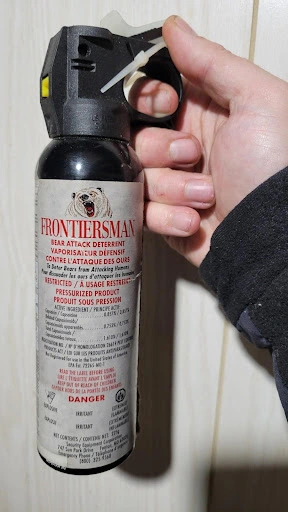Venturing into bear country without bear spray is like sailing without a life jacket—you might not drown but you’ll wish you brought it. Commonly available at outdoor retailers, bear spray is a tool that provides peace of mind, allowing adventurers to focus on what’s important – the adventure.
This article is a high level overview of bear spray and will guide readers through understanding how it works, its effectiveness, and how to use it properly so that you don’t injure yourself by mistake.
Table of Contents
What is Bear Spray?
Bear spray is a non-lethal deterrent designed to protect humans during close encounters with bears. It consists of a canister of aerosol that expels a fine mist of chemicals, which creates a barrier between the user and an aggressive bear.
The active ingredient in bear spray is capsaicin and it’s derived from chili peppers. These kinds of irritants affect the mucous membranes, causing intense burning sensations in the eyes, nose, throat, and lungs.
This temporary discomfort overwhelms the bear’s senses, discouraging it from advancing and providing the user with a window of time to retreat to safety.
From a scientific view, the effectiveness of bear spray stems from its ability to activate a bear’s trigeminal nerve, which is responsible for detecting facial irritants. But instead of it being brambles or dust, it’s hot pepper juice.
The immediate and intense reaction triggered by the capsaicin can stop a charging bear in its tracks, making bear spray a formidable line of defense. Unlike firearms, bear spray does not require precise aim, and its use can significantly reduce the number of bear attacks resulting in human injury.
Why You Need Bear Spray in Your Kit
As human populations expand and more people venture into wildlife habitats for recreation and adventure, the likelihood of encounters between humans and bears increases.
This interaction carries an inherent risk of bear aggression, particularly in areas where bears may not be accustomed to human presence. Often it will be due to a lack of education on our part.
Adventurers can use various methods to deter bears, such as clanging metal objects, playing loud music, or making themselves appear larger. While these techniques can be effective in altering a bear’s behavior or making one’s presence known, they are not foolproof.
Bear spray, on the other hand, offers a more reliable safety measure in the event of a close encounter. It provides a specific defense mechanism designed to stop an aggressive bear.
The other deterrent methods rely on the bear’s choice to retreat, which may not always happen, especially if the bear feels threatened or is protecting its young. Bear spray imposes a physical barrier of discomfort that can ward off even the most persistent of bears.
Shelf Life of Bear Spray and Proper Storage
Bear spray has an average shelf life of approximately 3 to 4 years—while that is a long time it is still important to check the expiry date on the can.
As the contents are pressurized and contain specific chemical formulations, the efficacy of bear spray diminishes past its expiry date. You’ll want to replace the expired cans so you don’t run into any nasty surprises out in the field.
Here are some general tips for storing your bear spray:
- Keep it Accessible: Store bear spray in a holster or an outer pocket of your backpack where you can grab it quickly in case of an emergency.
- Avoid Extreme Temperatures: Do not leave the bear spray in locations where it will be exposed to extreme heat or freezing conditions, as this can affect the pressure and potency of the spray.
- Monitor Condition: Regularly inspect the canister for any signs of corrosion or leakage.
- Educate Yourself: Familiarize yourself with the usage and safety mechanisms of the spray before venturing into bear country.
How to Use Bear Spray Correctly
Understanding the proper usage of bear spray can be the difference between a safe retreat and a dangerous encounter. Here’s how to use bear spray effectively:
- Positioning: If you encounter a bear, stay calm, speak to it in a firm tone to identify yourself as human, and slowly back away. Do not run.
- Remove Safety: Bear spray cans have safety mechanisms to prevent accidental discharge. Learn to disengage this quickly.
- Aim and Spray: Point the can downwards, aiming slightly in front of the approaching bear, and press the trigger. The spray will shoot out as a cloud towards the bear.
- Bursts: Deliver short bursts to conserve the spray—most cans last about 8 seconds in total if sprayed continuously.
- Retreat: While the bear is distracted or retreating, back away slowly and leave the area.
- Storage After Use: If some content remains in the can after use, reholster it securely but keep it readily accessible until you are out of bear territory.
If you have an empty can around it’s a good idea to practice holstering and reholstering the can. Also, practice removing the guard. Both of these are choke points that should be addressed before encountering an aggressive bear.
Common Mistakes to Avoid When Using Bear Spray
When it comes to using bear spray, certain missteps could greatly reduce its effectiveness and potentially put you at risk.
A common mistake is spraying into the wind, which may cause it to blow back onto yourself rather than reach the bear.
Pointing the spray canister at oneself is another error to avoid, as it might lead to self-contamination and incapacitation.
The last mistake is that people often forget to remove the safety guard in the heat of the moment, rendering the bear spray unusable during a critical encounter.
Final Thoughts
Anyone who has spent time in the backcountry will tell you that bear spray is an essential safety tool. Its proven effectiveness in deterring bear attacks makes it a top contender for non-lethal defense options.
Familiarizing yourself with the operation of the bear spray before embarking on your adventure is probably the single best piece of advice you can remember. Encountering bears is no different than any other creature you might find, just embrace the wild with respect and preparation.










